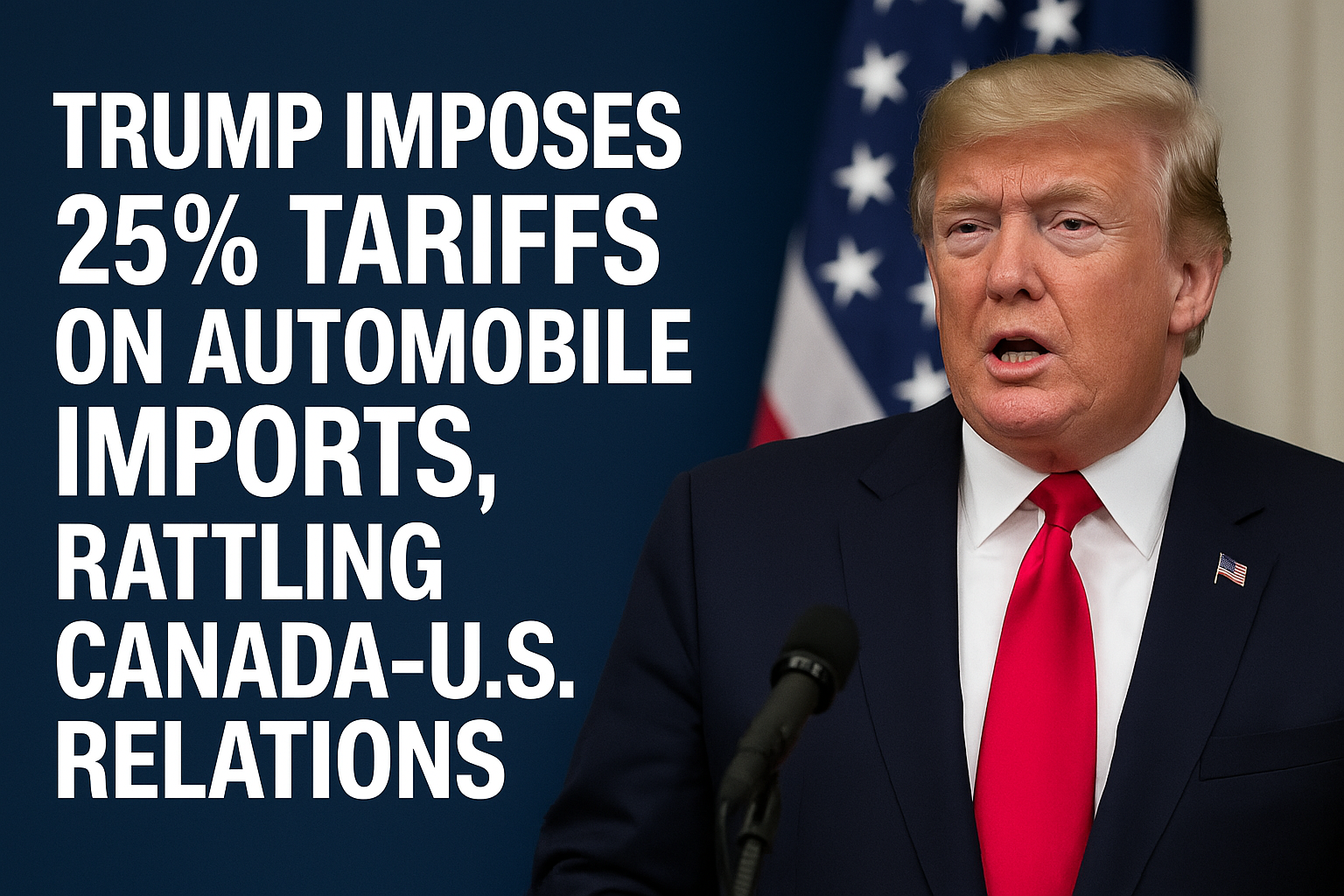In a move that has sent ripples through the automotive and political landscapes, U.S. President Donald Trump signed an executive order on Wednesday to impose a 25% tariff on all automobile imports, effective April 3. While the policy targets vehicles coming from overseas, the deep integration of the North American automotive industry means that Canadian imports could see a reduced rate due to the Canada-U.S.-Mexico Agreement (CUSMA).
Key Details of the Executive Order
The executive order, released late Wednesday, outlines that tariffs will be imposed on automobile imports, including parts such as engines, transmissions, and electrical components. However, vehicles imported from Canada under the CUSMA framework will only be taxed on the value of the content not made in the U.S. This clause reflects the highly interconnected nature of the North American auto industry.
In addition to the new tariffs, the White House has indicated that automobile parts from Canada will not immediately face tariffs. However, once U.S. Commerce Secretary Howard Lutnick, in consultation with U.S. Customs and Border Protection, sets up a mechanism to assess the non-U.S. content of these parts, the tariffs could extend to include them.
Reaction from Canada
The announcement has been met with harsh criticism from Canadian officials, with Prime Minister Mark Carney describing the move as a “direct attack” on Canadian autoworkers. He emphasized that Canada would take swift action to protect its workers, companies, and national interests. Carney further criticized the decision as “entirely inconsistent” with CUSMA and the long-standing trade relationships between Canada and the U.S., which dates back to the 1965 Auto Pact.
The timing of the tariffs adds to the political tension in Canada, as they coincide with the ongoing federal election campaign. Carney’s response underscores Canada’s commitment to standing firm against what many perceive as an unwarranted attack on its auto sector.
The Impact on the U.S. and Canadian Auto Industries
The tariffs have already had a noticeable impact on the stock prices of major automakers. Shares of Stellantis, Ford, and General Motors all saw declines in after-hours trading. Tesla, too, felt the sting of the announcement.
Trump’s call for automakers to bring their parts manufacturing back to the U.S. further fuels the uncertainty hanging over the auto industry. As the president’s tariffs on steel and aluminum imports earlier this month demonstrated, the effects of his trade policies are wide-reaching. His announcement has left the industry scrambling to understand how to navigate the new rules.
While some are hopeful that the new tariffs will prompt automakers to shift operations to the U.S., others, such as Dave McDowell, president of Unifor Local 1859, see the move as yet another blow to stability. McDowell, who works at a St. Catharines-based auto parts manufacturer, explained that uncertainty continues to plague the sector. His concern echoes the broader anxiety among workers, with many unsure of what the future holds for their jobs.
Political Fallout in Canada
In the political arena, opposition leaders in Canada have seized on the tariffs as a key campaign issue. Conservative Leader Pierre Poilievre has urged President Trump to “knock it off,” arguing that the tariffs are causing chaos in markets and harming workers on both sides of the border. Poilievre’s criticism has been echoed by NDP Leader Jagmeet Singh, who suggested that Carney should have recalled Parliament to legislate emergency measures to support workers who may be laid off as a result of the tariffs.
Ontario Premier Doug Ford, too, voiced his frustration with the U.S. administration’s unpredictable behavior, stating, “I honestly believe the American administration some days can’t predict what President Trump’s going to say.” Ford has been vocal about the need for Canada to stand firm in its response to the tariffs. He’s called for retaliatory action, stressing the need to fight back and defend Canadian interests.
Carney’s Response and Canada’s Strategy
Prime Minister Carney’s government has been proactive in addressing the tariffs’ potential impact. On the same day the tariffs were announced, Carney pledged a $2-billion Strategic Response Fund aimed at protecting manufacturing jobs in Canada. He also outlined plans to build more auto parts domestically, signaling Canada’s resolve to minimize the negative effects of the tariffs on its workers and economy.
Lana Payne, national president of Unifor, echoed these sentiments, reaffirming the vital role Canadian autoworkers have played in the country’s economy for over a century. She stressed that these jobs belong to Canadians, not to President Trump, and vowed to do everything possible to ensure they remain in Canada.
What’s Next for the Auto Sector?
With the looming threat of tariffs, both U.S. and Canadian automakers face a future fraught with uncertainty. Will manufacturers move their operations to the U.S. to avoid the tariff burdens? How will this reshuffle affect the auto parts supply chain in North America?
The situation remains fluid, with much depending on the U.S. administration’s next steps and the response from Canada. For now, the tariffs represent a significant challenge for the auto industry — and for the workers who depend on it.
As we wait for April 3, one thing seems certain: the trade tensions between the two countries will only intensify. Will these tariffs mark a turning point in U.S.-Canada relations, or will cooler heads prevail in the face of economic fallout? Only time will tell, but one thing is for sure — it’s not business as usual in North America’s auto industry.



